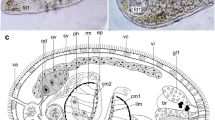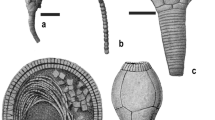Abstract
Within the last two decades, syntheses of both light-microscopic and ultrastructural characters have shown that there are three well-defined monophyletic groups within the Platyhelminthes: 1) the Catenulidale, 2) the Nemertodermatida-Acoela, and 3) the Haplopharyngida-Macrostomida-Polycladida-Neoophora (+ parasitic platyhelminth classes). However, the relationships among these three groups are problematic. The possible apomorphies that would unite them are either not true homologues (i.e. frontal organ), are mutually conflicting (i.e. 9+1 axoneme in spermatozoa vs. biflagellate spermatozoa, epidermal ciliary rootlet structure, and protonephridia), or are unrooted with any outgroup and hence untestable or uncertain as apomorphies (protonephridia, mode of epidermal replacement, absence of accessory centrioles on cilia). The chief obstacle to deciphering the relationships of these groups is the lack of information on them; presently available information is insufficient to test potential synapomorphies and insufficient also to allow agreement upon a narrowly defined outgroup for the Turbellaria.
A view consistent with the present evidence (and admittedly an unsatisfactory view) is to regard the Turbellaria (and hence the Platyhelminthes) as polyphyletic, consisting of three separate and unrelatable groups.
Similar content being viewed by others
References
Ax, P., 1961. Verwandtschaftsbeziehungen und Phylogenie der Turbellarien. Ergebn. Biol. 24: 1–68.
Ax, P., 1984. Das phylogenetische System. Systematisierung der lebenden Natur auf Grund ihrer Phylogenese. G. Fischer, Stuttgart, New York, 349 pp.
Baccetti, B. & B. A. Afzelius, 1976. The biology of the sperm cell. Monographs in Development Biology 10, 254 pp.
Ball, I. R., 1974. A contribution to the phylogeny and biogeography of freshwater triclads (Platyhelminthes: Turbellaria). In N. W. Riser & M. P. Morse (eds), Biology of the Turbellaria. McGraw-Hill, New York: 339–401.
Doe, D. A., 1981. Comparative ultrastructure of the pharynx simplex in Turbellaria. Zoomorphology 97: 133–193.
Dorey, A. E., 1965. The organization and replacement of the epidermis in acoelous turbellarians. Quart. J. microsc. Sci. 106: 147–172.
Ehlers, U., 1977. Vergleichenden Untersuchungen über Collar-Rezeptoren bei Turbellarien. Acta zool. fenn. 154: 137–148.
Ehlers, U., 1984. Das phylogenetische System der Plathelminthes. Habilitationsschrift, Universität Göttingen.
Ehlers, U., 1985a. Phylogenetic relationships within the Platyhelminthes. In S. Conway Morris, J. D. George, R. Gibson, H. M. Platt (eds), Origins and relationships of lower invertebrates. University Press, Oxford. (in press)
Ehlers, U., 1985b. Comments on a phylogenetic system for the Platyhelminthes. This volume.
Ferrero, E., 1973. A fine structure analysis of the statocyst in Turbellaria Acoela. Zool. Scr. 2: 5–16.
Hein, C., 1928. Zur Kenntnis der Regenerationsvorgänge bei den Rhabdocoelen. Mit Angaben über den feineren Bau und die Lebensäusserungen. Z. wiss. Zool. 130: 469–546.
Hendelberg, J., 1977. Comparative morphology of turbellarian spermatozoa studied by electron microscopy. Acta zool. fenn. 154: 149–162.
Hendelberg, J., 1983. Platyhelminthes — Turbellaria. In K. G. Adiyodi & R. G. Adiyodi (eds), Reproductive biology of invertebrates. Vol. II, Spermatogenesis and sperm function. J. Wiley & Sons, Ltd., Chichester: 74–104.
Hendelberg, J., 1985. The phylogenetic significance of sperm morphology. This volume.
Hendelberg, J. & K.-O. Hedlund, 1974. On the morphology of the epidermal ciliary rootlet system of the acoelous turbellarian Childia groenlandica. Zoon 2: 13–24.
Hennig, W., 1950. Grundzüge einer Theorie der phylogenetischen Systematik. Deutscher Zentralverlag, Berlin.
Hori, I., 1978. Possible role of rhabdite-forming cells in cellular succession of the planarian epidermis. J. electr. Microsc. 27: 89–102.
Karling, T. G., 1940. Zur Morphologie und Systematik der Alloeocoela Cumulata und Rhabdocoela Lecithophora (Turbellaria). Ark. Zool. 10: 331–345.
Karling, T. G., 1965. Haplopharynx rostratus Meixner (Turbellaria) mit den Nemertinen vergleichen. Z. zool. syst. Evolutionsforsch. 3: 1–18.
Karling, T. G., 1974. On the anatomy and affinities of the turbellarian orders. In N. W. Riser & M. P. Morse (eds), Biology of the Turbellaria. McGraw-Hill, New York: 1–16.
Klauser, M., J. P. S. Smith & S. Tyler, 1985. Ultrastructure of the frontal organ of Convoluta ‘pulchra’ and Macrostomum spp.: significance for the turbellarian archetype. This volume.
Kümmel, G., 1962. Zwei neue Formen von Cyrtocyten. Vergleich der bisher bekannten Cyrtocyten und Ergänzung des Begriffs ‘Zelltyp’. Z. Zellforsch. 57: 172–201.
Luther, A., 1904. Die Eumesostominen. Z. wiss. Zool. 77: 1–273, Taf. I–X.
Lyons, K. M., 1977. Epidermal adaptions of parasitic platyhelminths. Symp. zool. Soc. London 39: 97–144.
Mamkaev, Yu. V., 1979. On histological organization of the turbellarian digestive system. [in Russian] Proc. zool. Inst. Acad. Sci. U.S.S.R. 84: 13–24.
Marchand, B. & X. Mattei, 1976. Ultrastructure du spermatozoide de Centrorhynchus milvus Ward, 1956 (Paleacanthocephala, Polymorphidae). C. r. Séanc. Soc. Biol. 170: 237–241.
Martin, V. J. & M. B. Thomas, 1981. The origin of the nervous system in Pennaria tiarella as revealed by treatment with colchicine. Biol. Bull. 160: 303–310.
Moraczewski, J., 1977. Asexual reproduction and regeneration of Catenula (Turbellaria, Archoophora). Zoomorphologie 88: 65–80.
Moraczewski, J., 1981. Fine structure of some Catenulida (Turbellaria Archoophora). Zool. pol. 28: 367–415.
Remane, A., 1956. Die Grundlagen des natürlichen Systems, der vergleichenden Anatomie und der Phylogenetik. Akademische Verlagsgeselschaft, Leipzig, 364 pp. (Reprinted 1971 by Otto Koeltz, Königstein, Taunus.)
Reuter, M. & I. Palmberg, 1983. Asexual reproduction in Microstomum lineare (Turbellaria). II. The nervous system in the division zone. Int. J. invert. Reprod. 6: 207–217.
Rieger, R. M., 1976. Monociliated epidermal cells in Gastrotricha: Significance for concepts of early metazoan evolution. Z. zool. Syst. Evolutionsforsch. 14: 198–226.
Rieger, R. M., 1978. Multiple ciliary structures in developing spermatozoa of marine Catenulida (Turbellaria). Zoomorphologie 89: 229–236.
Rieger, R. M., 1981. Morphology of the Turbellaria at the ultrastructural level. Hydrobiologia 84: 213–229.
Rieger, R. M., 1985. Asexual reproduction and the turbellarian archetype. This volume.
Rieger, R. M. & M. Mainitz, 1977. Comparative fine structural study of the body wall in Gnathostomulida and their phylogenetic position between Platyhelminthes and Aschelminthes. Z. zool. syst. Evolutionsforsch. 15: 9–35.
Rieger, R. M. & S. Tyler, 1979. The homology theorem in ultrastructural research. Am. Zool. 19: 654–666.
Skaer, R. J., 1965. The origin and continuous replacement of epidermal cells in the planarian Ploycelis tenuis (Iijima). J. Embryol. exp. Morph. 13: 129–139.
Smith, J. P. S., 1981. Fine-structural anatomy of the parenchyma in the Acoela and Nemertodermatida (Turbellaria). Ph.D. Dissertation, University of North Carolina, Chapel Hill.
Smith, J. P. S. & S. Tyler, 1985a. The acoel turbellarians: kingpins of metazoan evolution or a specialized offshoot? In S. Conway Morris, J. D. George, R. Gibson, H. M. Platt (eds), Origins and relationships of lower invertebrates. University Press, Oxford. (in press)
Smith, J. P. S. & S. Tyler, 1985b. Frontal organs in the Acoelomorpha: ultrastructure and phylogenetic significance. This volume.
Smith, J. S., S. Tyler, M. B. Thomas & R. Rieger, 1982. The nature of turbellarian rhabdites: phylogenetic implications. Trans. am. microsc. Soc. 101: 209–228.
Sopott-Ehlers, B., 1985. The phylogenetic relationships within the Seriata (Platyhelminthes). In S. Conway Morris, J. D. George, R. Gibson, H. M. Platt (eds), Origins and relationships of lower invertebrates. University Press, Oxford. (in press).
Steinböck, O. 1925. Zur systematik der Turbellaria metamerata. Zool. Anz. 64: 165–192.
Sterrer, W. & R. Rieger, 1974. Retronectidae — a new cosmopolitan marine family of Catenulida (Turbellaria). In N. W. Riser & M. P. Morse (eds), Biology of the Turbellaria. McGraw-Hill, New York: 63–92.
Tyler, S., 1976. Comparative ultrastructure of adhesive systems in the Turbellaria. Zoomorphologie 84: 1–76.
Tyler, S., 1979. Distinctive features of cilia in metazoans and their significance for systematics. Tissue Cell 11: 385–400.
Tyler, S., 1984. Turbellarian platyhelminths. In J. Bereiter-Hahn, S. Matoltsy, K. S. Richards (eds), Biology of the integument, Vol. 1, Invertebrates. Springer-Verlag, Berlin: 112–131.
Tyler, S. & R. M. Rieger, 1977. Ultrastructural evidence for the systematic position of the Nemertodermatida (Turbellaria). Acta zool. fenn. 54: 193–207.
Westblad, E., 1948. Studien über Skandinavische Turbellaria Acoela V. Ark. Zool. 41A: 1–82.
Wiley, E. O., 1981. Phylogenetics. The theory and practice of phylogenetic systematics. Wiley Interscience, New York, 439 pp.
Wilson, R. A., L. A. Webster, 1974. Protonephridia. Biol. Rev. 49: 127–160.
Author information
Authors and Affiliations
Rights and permissions
About this article
Cite this article
Smith, J.P.S., Teyler, S. & Rieger, R.M. Is the Turbellaria polyphyletic?. Hydrobiologia 132, 13–21 (1986). https://doi.org/10.1007/BF00046223
Issue Date:
DOI: https://doi.org/10.1007/BF00046223




